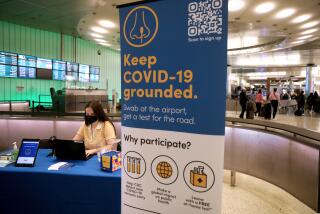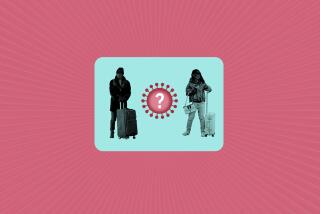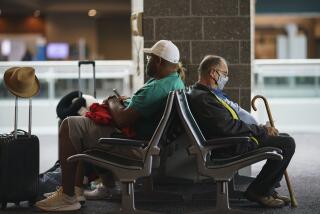Jet Detained on Mystery Illness Fears
SAN JOSE — An American Airlines plane from Asia with 139 passengers and crew on board was isolated for two hours Tuesday when several travelers complained of symptoms similar to a mysterious respiratory illness that has killed at least 62 people and sickened nearly 2,000 worldwide.
By early afternoon, health officials in Santa Clara County had determined that none of the passengers -- three of whom were taken to a local hospital for evaluation -- were suffering from the disease called SARS, or Severe Acute Respiratory Syndrome. The plane, after a cleaning, was back in service.
“It’s very easy in retrospect to say this was an awful lot of effort and no one had SARS ... ,” said Dr. Karen Smith, Santa Clara County’s public health officer. “But it’s important to be responsible. We did what we thought was best.”
The decision to isolate the plane and delay passengers, a situation county health officials said never rose to the level of a quarantine, prompted criticism from authorities at other airports who said the measures were not necessary.
National public health officials said they don’t recommend isolating planes or keeping passengers aboard if a case is suspected.
Even before Flight 128’s passengers were deemed clear of SARS, county health officials acknowledged the difficulties posed by the potential of an outbreak.
“If every flight coming back from Asia on which someone’s coughing has to go through this procedure, I don’t see how that’s feasible,” Smith said.
Still, Smith said she believed that the American Airlines crew had done its best given the information that was available.
“I do think there is a need at the national level for more guidance to the airlines,” she said. “I’m hoping that will be forthcoming. The airline industry is going to be impacted.”
The reaction highlighted the fears that the potentially deadly illness could break out further in the United States, spread by travelers from Asia, where SARS already has taken lives and sickened scores of others.
The United Nations health agency today advised travelers to avoid Hong Kong and the southern Chinese province of Guangdong because of the outbreak.
The World Health Organization said it was taking the action because at least nine foreign businessmen have contracted the illness in Hong Kong and returned home with it.
In California, live feeds from the airport, with pictures of masked medical personnel, were broadcast on television news.
Gov. Gray Davis held a news briefing to assuage concerns. Within hours, however, the crisis had passed, leaving instead serious questions about how international travelers should be handled in light of the illness’ threat.
Flight 128 left Tokyo with five passengers who had transferred from a flight out of Hong Kong.
The pneumonia-like illness there has caused a public health panic, with hundreds falling ill, more than a dozen dead and entire apartment buildings vacated.
At Tokyo’s Narita Airport, passengers arriving from Hong Kong were not required to make any special health declaration before they boarded the flight, according to a spokesman.
“All we have to depend on is the passengers’ self-awareness, knowledge of the disease and actual symptoms if they have any,” said Kenichi Ochiai, information officer at the Narita quarantine office.
Flight 128’s pilot radioed for assistance while en route after learning that a handful of passengers had complained of SARS-like symptoms. The respiratory illness is believed to be caused by an airborne virus transmitted through close contact with an infected person.
According to county health officials, the pilot’s radio call set in motion a series of high-level responses contained in their emergency plans. The airport honored the pilot’s request to land in a remote location on the tarmac. Airport officials then called local fire and police departments, who in turn notified county health officials.
The U.S. quarantine station at San Francisco International Airport, which has jurisdiction for Northern California entry, was contacted, said Ken August, a spokesman for the California Department of Health Services.
Just this week, the Centers for Disease Control and Prevention issued guidelines for the airline industry regarding cases of respiratory illness on flights from Hong Kong, China’s Guangdong Province and Hanoi.
The guidelines require the captain to report the illness to the nearest U.S. Quarantine Station.
The guidelines also explain decontamination procedures for the airplane, and strongly advise other passengers to immediately wash their hands.
For travelers worn out after the overnight trans-Pacific flight, the further delay initially appeared routine.
Newlyweds Hidehiro Kamiya, 32, and his wife, Sadami, 25, said no announcements were made until after the plane landed shortly after 10 a.m. and people began to gather their luggage.
The couple said they were then told in English and Japanese to return to their seats because the airplane was to be inspected.
About half an hour later, the couple said, another announcement was made that some people on board were showing symptoms of illness.
Before that announcement, Robert Salmons, 48, a business manager for a high-tech firm who was returning from a three-week business trip in Asia, said passengers could see emergency vehicles and personnel circling the airplane.
Salmons said the pilot had announced that they were looking for thermometers to see if anyone on board had a temperature above 101 degrees, but did not explain why.
Salmons said he used his cell phone to call local media outlets until he found someone who told him that there were suspected SARS cases on board.
Everyone on board remained calm while public health officials boarded the plane in white coats and masks.
All passengers were asked to give their whereabouts for the next two weeks, given information about SARS symptoms and cautioned to seek medical attention if they felt ill.
In the end, three passengers, ages 50, 70 and 74, were taken to an emergency room for evaluation and released within a few hours.
Two additional passengers, who declined to be taken to a hospital, were examined at the scene and allowed to leave because their symptoms and travel histories were not consistent with what is known about the illness.
Nearly all on board began the nine-hour, nonstop flight from Tokyo, which world health officials do not consider a problem spot for the virus.
U.S. public health officials, while urging caution, said there is no reason to panic about the mysterious illness.
The United States has logged 69 cases of SARS and no deaths, far fewer than Asian countries and Canada. Experts attribute the ability to contain the illness in the U.S. to hospital infection-control measures and heightened vigilance.
Studies are being conducted to determine why people here haven’t gotten as sick as people in other countries.
“You can’t take all the planes with someone who has a mild cold and say we’re going to quarantine the whole plane,” said Dr. Allan Rosenfield, dean of the Mailman School of Public Health at Columbia University.
“There’s got to be the use of common sense until we get a better sense of what we’re dealing with.... “
The California Department of Health Services said it has received reports of 20 suspected cases in the state, all connected to travel to Southeast Asia.
Michael DiGirolamo, deputy executive director of airport operations and public safety for the agency that operates Los Angeles International Airport, said their response plan calls for passengers within two rows of the infected person to closely monitor their health. Everyone else would be allowed off the plane immediately, he said.
DiGirolamo said airports have faced similar concerns before.
“It’s a problem. It’s more at this point perception rather than reality,” he said. “We’ve had this happen before when we had the Ebola virus about five years ago. We had pilots that were coming in and wanted to quarantine airplanes and public health said, ‘Don’t have to do that, it’s not that contagious.’ ”
*
Times staff writers Jennifer Oldham, Megan Garvey, Steve Hymon and Dan Morain contributed to this report. Hisako Ueno of The Times’ Tokyo bureau also contributed.
*
(BEGIN TEXT OF INFOBOX)
Severe Acute Respiratory Syndrome
What are the symptoms of Severe Acute Respiratory Syndrome (SARS)?
The illness usually begins with a fever of greater than 100.4 degrees. The fever is sometimes associated with chills or other symptoms, including headache, a general feeling of discomfort and body aches. Some people also experience mild respiratory symptoms at the outset of illness.
After two to seven days, SARS patients may develop a dry cough that may progress to the point where insufficient oxygen is getting to the blood. In 10% to 20% of cases, patients will require the use of a ventilator.
Suspected patients would have been in mainland China, Hong Kong, Hanoi or Singapore within 10 days of the onset of symptoms, or had close contact with someone who recently traveled to those areas. The fatality rate among people with the illness is about 3%.
How is SARS spread?
The principal method appears to be through droplet transmission when someone infected with SARS coughs or sneezes droplets into the air and someone else breathes them in. It is possible that SARS can be transmitted more broadly through the air or from contaminated objects.
What medical treatment is recommended for patients with SARS?
The CDC recommends that patients receive the same treatment that would be used for any patient with serious pneumonia of unknown cause. Several treatments have been used, but there is insufficient information to determine whether they work. Reported therapeutic regimens have included antibiotics and antiviral agents such as oseltamivir or ribavirin. Steroids also have been administered orally or intravenously to patients in combination with ribavirin and other antimicrobials.
Are there any travel restrictions related to SARS?
At this time there are no travel restrictions directly related to SARS. However, a CDC travel advisory recommends that people planning nonessential or elective travel to mainland China, Hong Kong, Hanoi or Singapore postpone their trips.
What should I do if I have recently traveled to a country where cases of SARS have been reported?
You should monitor your health for 10 days following your return. If you become ill with a fever of over 100.4 degrees that is accompanied by a cough or difficulty breathing, you should consult a doctor.
Source: Centers for Disease Control and Prevention
Los Angeles Times
More to Read
Sign up for Essential California
The most important California stories and recommendations in your inbox every morning.
You may occasionally receive promotional content from the Los Angeles Times.










